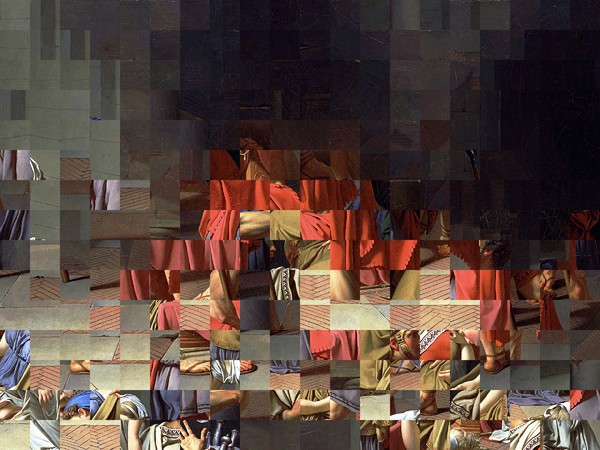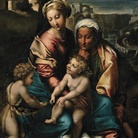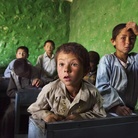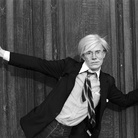Art for Education: Contemporary Artists from Pakistan

From 17 Ottobre 2018 to 25 Novembre 2018
Milan
Place: Museo Diocesano Carlo Maria Martini
Address: piazza Sant’Eustorgio 3
Times: from Tuesday to Sunday, from 10 am to 6 pm. Closed on Monday (except holidays) Ticket office closes at 5.30 pm
Responsibles: Salima Hashmi, Rosa Maria Falvo
Organizers:
- Patrocinio di
- Regione Lombardia
- Comune di Milano
- Ambasciata Pakistana Roma
- Ambasciata d’Italia Islamabad
- Consolato d’Italia a Karachi
- Centro di Cultura Italia-Asia
Ticket price: Full price: 8 euros Reduced: 6 euros
Telefono per informazioni: +39 02.89420019
E-Mail info: info.biglietteria@museodiocesano.it
Official site: http://italianfriends-tcf.org
Organized in partnership with Museo Diocesano Carlo Maria Martini, the exhibition is curated by Salima Hashmi, a Pakistani artist, critic and intellectual, and Rosa Maria Falvo, an Italian-Australian critic and writer. On display will be the works of sixty Pakistani artists - including international renowned and emerging artists, the latter selected in part through a competition held by Italian Friends of TCF in 2017. Many of these artists know and have long supported The Citizens Foundation; their work has been donated to the exhibition for the purpose of raising funds for the Pakistani NGO.
The main theme of the project is that from which the exhibition itself takes its title, Art for Education; indeed education is the driving force behind The Citizens Foundation and represents a universal value for individual and collective growth. Education and artistic creation reflect an important aspect of the culture of Pakistan and have always been closely connected. Many of the artists present in the show are or have been teachers, becoming real mentors for their students outside the university setting, demonstrating that art can and does reveal and critique a society’s status quo.
In their work, these Pakistani artists deal with contemporary topics from their particular point of view, with the sensitivity and nuance that only those who experience every day life in Pakistan can have. Unlike the country often depicted, Pakistan is experiencing a great cultural and artistic ferment that coexists with a contradictory and onerous history made of divisions, dictatorship and the "Muslim dream" that has transformed the industrial capital, Karachi, into one of the most multi-ethnic and populous cities of the world with its 23.5 million inhabitants.
Curator Salima Hashmi offers us an accurate and stimulating snapshot of Pakistani art today when she writes:“It’soddthattheworsethingsare,thebetterartbecomes.”Pakistaniartisoftencloselyrelated to artistic and individual freedom and the possibility of self expression, even in conditions not always favorable to freedom of thought. It is nuanced and refined, strongly symbolic and suggestive, reflecting the contradictions of today’s society. At the same time, it is revolutionary because it speaks softly but powerfully. It projects beyond borders, celebrating its traditions, preserving idealism and passion despite the sometimes challenging circumstances.
It is no coincidence that traditional artistic techniques such as miniature, embroidery, weaving, and calligraphy are still taught in art schools and universities; thus it is not surprising hat artists of new generations make full use of them. Studying and learning from more or less recent history, once again the theme of Art for Education is highlighted along with the intention not of erasing the past, but rather using it as a stimulus for changing society for the better: an act of courage and responsibility that allows artists to face issues such as poverty, injustice, Islam, the role of women, gender identity, love, and urbanization. Through refined use of technique, they create artifacts that are aesthetically fascinating and which, at the same time, conceal difficult and sometimes taboo topics. Participating artist Faiza Buttsays: “Beauty is a trap” in reference to the fact that the beauty of her works lures the viewer to approach and discover its deeper meaning, related to gender identity, childhood, and the society in which she lives. The artist uses the technique of pointillism borrowed from the Mughal miniature and applies it to photographs found in newspapers and magazines, and to the pixels of which they are made. A similar technique is utilized by Rashid Rana in War Within VI: starting from the iconic neoclassical work The Oath of the Horatii by Jacques-Louis David, he creates an effect of estrangement between the viewers’ perspective from a distance and close-up, while engaging the theme of nationalism and its violent outcomes. At the same time Imran Qureshi - who attended and now teaches miniature at the National College of Arts in Lahore and is one of the better-known participating artists - deals with the themes of death and life, of tragedy and hope, in his extremely elegant paintings.
Most of the artists whose work is on show are women. This is not by chance but is related to Pakistani tradition and history: in ancient times, craftsmanship was practiced at home primarily by women, and even in recent times it was much easier for a woman to attend an art school than a university. Today, being an artist and a woman in Pakistan has an added value of which we have many examples, first of all Adeela Suleman, artist and director of the department of Fine Arts at the Indus Valley School of Art and Architecture in Karachi. In her sculptures/installations full of allegorical meaning, the artist works on the boundaries between natural beauty, violence and chaos, sublimating earthly fears through art. Changing the artistic tradition, not only Pakistani but also Western, combining it with current issues, is the path pursued by other artists such as Aisha Khalid, Hamra Abbas andNusra Latif Qureshi; in the artwork donated for the exhibition, the last works on the selective interpretation of religious texts applied to women, showing how, in the wrong hands, the same word that educates and frees can become an instrument of suppression Or there is Naiza Khan, who, like many other contemporary artists, reflects on the theme of urbanization and ruin, wondering how to re-imagine sociality amid the daily violence of post-colonial globalization.
Emerging artists too show their knowledge of the history of their country and its artistic techniques of the past. They know how to translate them into current events, proposing ideas for universal and strongly contemporary reflections: from the intimate work of Rehana Mangi to Mahbub Jokhio, whose works on the concepts of seeing, reading, perceiving and interpreting, using the Quran and a poem by the Sindhi sufi poet Shah Latif; from Seema Nusrat and her barricades to Imran Mudassarwho, through depiction of a student (Talib-i Ilm) of the Madrassa and through the floral motifs taken from the traditional models of Islamic design, stigmatizes the possessiveness of religious dogmas that these individuals embody for their entire lives. Sana Obaid uses wasli paper, a particular handmade paper for miniatures, giving us a light and, at the same time, shocking image. Asif Khan builds new narratives using stills from a documentary about the Pakistan partition from India. Shakila Haiderworks on the same story, intertwined with personal and dramatic events, while Ayesha Durraniinvestigates the concept of “female beauty” and its representation, always looking at the miniature.
The exhibition, Art for Education: Contemporary Artists from Pakistan, w hose presentation was conceived and designed by the architect Natasha Calandrino Van Kleef, is the joint effort of Italian Friends of TCF, the curators and the artists involved in supporting the activities of The Citizens Foundation through art - but not only. The purpose of the exhibition is to contribute to the knowledge of Pakistan in Italy, establishing an intercultural dialogue and a reflection on the role and importance of education in art and art in education.
Opening 16th October 2018 - 6.30 pm
SCARICA IL COMUNICATO IN PDF

-
 Dal 31 gennaio 2024 al 04 maggio 2025
Fermo | Palazzo dei Priori
Dal 31 gennaio 2024 al 04 maggio 2025
Fermo | Palazzo dei Priori
-
 Dal 20 dicembre 2024 al 04 maggio 2025
Fermo | Palazzo dei Priori
Dal 20 dicembre 2024 al 04 maggio 2025
Fermo | Palazzo dei Priori
-
 Dal 20 dicembre 2024 al 04 maggio 2024
Gorizia | Palazzo Attems Petzenstein
Dal 20 dicembre 2024 al 04 maggio 2024
Gorizia | Palazzo Attems Petzenstein
-
 Dal 18 dicembre 2024 al 18 dicembre 2024
Venezia | Museo Correr
Dal 18 dicembre 2024 al 18 dicembre 2024
Venezia | Museo Correr
-
 Dal 14 dicembre 2024 al 02 marzo 2025
Palermo | Palazzo Abatellis
Dal 14 dicembre 2024 al 02 marzo 2025
Palermo | Palazzo Abatellis
-
 Dal 12 dicembre 2024 al 23 febbraio 2025
Roma | Palazzo Altemps
Dal 12 dicembre 2024 al 23 febbraio 2025
Roma | Palazzo Altemps


